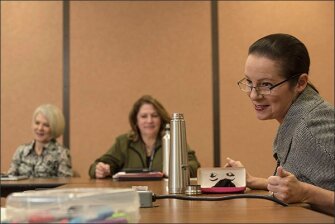For Highline Public 69��ý, the journey towards greater interoperability started in earnest about five years ago, the result of a dramatic influx of new classroom technologies and rising questions about how to safely and effectively make use of all the digital information they generated.
“You can’t have data from ten different systems coming together and expect a lay person to be able to read it without a common platform,” said Mark Finstrom, the chief technology officer for the 20,000-student district near Seattle. “I need data that is actionable.”
That pretty much sums up why there’s a growing push for better data interoperability in K-12 schools. Broadly speaking, the term refers to the seamless exchange of information between different systems and devices. That can include class rosters, student performance information, digital content, and more. According to new survey results from the Consortium for School Networking and the Education Week Research Center, district technology leaders around the country overwhelmingly agree that getting that information to flow freely in a single stream can help with everything from state and federal reporting, to class scheduling, to building better data dashboards.
But while there’s growing interest in the idea, making K-12 data interoperable is easier said than done.
The field has yet to settle on a unified approach to the technical standards that make truly seamless data-sharing possible. Some ed-tech vendors view interoperability as a threat to their business models. The Education Week/CoSN survey found that CTOs and CIOs experience a number of barriers to promoting the concept, starting with budget constraints and lack of technical expertise.
And given the fractious environment, some school technology leaders worry that taking a strong stand on the issue could mean that classrooms lose access to valuable learning apps and software.
“Do I want to make sure my 21,000 students are getting the best learning materials available, or dig my heels in to make a point?” said Diane Doersch, the chief information and technology officer for Wisconsin’s Green Bay Area Public 69��ý.
To light the way forward, interoperability-advocacy groups are increasingly pointing to leaders in the field, including Highline.
Under Finstrom’s direction, the district has built its own system for storing and managing digital information, hiring staff with job titles such as “data integration and visualization director” to make sure information is presented in usable ways. Work is also underway to bring data on student performance, attendance, and behavior together in a single place with classroom observations, profiles of educators, district-level operational data, and each school’s annual improvement plan.

“We’re all going to learn something from Highline,” said Erin Mote, the executive director of Innovate EDU, a New York-based nonprofit that helps run the interoperability effort known as . “I think they’re a great example of a district that is trying to push the frontiers.”
Lost Time, Vulnerable Data
Finstrom has been Highline’s CTO for the past seven years, and a technology leader in the district for the past 13.
The whole time, he says he’s been borderline-obsessed with figuring out the best ways to manage the district’s data.
For years, that took the form of a data warehouse, along with a lot of improvised data exchanges with the district’s various technology vendors. Early on, those exchanges might occur manually, with large files transferred via an FTP server. Eventually, more vendors began adopting application-programming interfaces, or APIs, to facilitate the exchange of information.
District chief technology officers who are trying to implement interoperability offered suggestions for peers in other school systems.
But the data Highline sent and received still had to be put in different formats for different vendors. Missing fields and corrupted files would send district staff down time-sucking rabbit holes, trying to find the source of the problem.
And more importantly, Finstrom said, that scattershot system limited the usefulness and security of Highline’s data. It was hard for his team to make adjustments to respond to the requests and needs of state officials, or school board members, or principals. The district was overly reliant on vendors for answers about their products’ impact. Different vendors stored different bits of student and district data on their own servers.
“If you don’t have the ability to control the way data are moving, you end up having a mess,” Finstrom said.
Highline’s response was to move away from the data-warehouse model, and towards greater interoperability.
The district didn’t embrace a particular technical standard, Finstrom said.
Instead, his team created its own relational databases, hosted on its own servers, in order to gain more flexibility and control over how they queried their own information, while also purchasing specific data-management tools as needed.
They also developed their own schema for how data should be formatted and transmitted, and then insisted that its vendors comply—or at least make an honest effort—if they wanted to keep the district’s business.
Those steps have allowed Highline to control what Finstrom described as “one authoritative source of information” from which he can “funnel data to other sources.”
Now, the same criteria guide how information is collected for dozens of different software tools used in Highline classrooms.
Each night, computer programs run to update class rosters and other information and extract data for a series of reports on topics such as how the district’s 5th grade classrooms compare with each other when it comes to the reading performance of English language learners, or behavior and attendance.
And Finstrom’s team can build custom dashboards in a software program called Tableau for administrators from other departments, such as accountability, teaching and learning, and human resources.
It hasn’t been cheap, Finstrom conceded.
But the ability to make a wide a range of decisions with the benefit of better data has made the interoperability push worth it.
“We’re doing things Fortune 500 companies want to do with their data, and we’re just a school district,” he said.
‘B�����-����-���������’
The vast majority of districts around the country are still in the early stages of pushing for greater interoperability, said Mote of Project Unicorn.
Take Green Bay, for example. Doesrch, the district’s technology chief, said she’s been on the lookout for a one-stop solution. But none of the standards or tools available seemed comprehensive enough. So Green Bay to date has mostly taken an ad hoc approach, tackling specific problems, such as making classroom software sign-ons smoother, where possible.
Still, what truly makes Highline’s approach “best-in-class,” Mote said, is two things: Where they’re still trying to get; and the highly collaborative process by which they’re trying to get there.
Indeed, it was Rebekah Kim, Highline’s executive director of teaching and learning, who most clearly laid out the district’s interoperability vision.
The goal is to move beyond meeting the information needs of each department, Kim said, and to move towards the point where previously disparate streams of data can be easily examined side-by-side.
“The systems we have in place, from operations to human resources to the classroom, all influence each other,” Kim said. “So we want to be able to answer questions like, ‘Does the consistency of transportation pick-up times influence student attendance and chronic absenteeism?’”

To get there, Highline is in the midst of a year-long process, led by four working groups.
One will focus on teacher and principal profiles. Another will look at student profiles.
A third group will consider how to standardize classroom observation data and make them more easily integrated with other streams of information.
And the final working group will look at the interoperability of the data behind each school’s unique improvement plan, so principals can easily gauge progress on their own specific goals and strategies.
How would having all those systems talking to each other impact the district?
Among other things, Finstrom said, it will allow Highline to radically reconsider how it staffs schools—for example, by better understanding where and how to recruit the teachers who are most successful working with middle school students whose first language is Vietnamese.
This Education Week examination of school districts’ pursuit of interoperability is the first of three special reports focused on the needs of K-12 district technology leaders, including chief technology officers. Each report in the series features exclusive results of a new, nationally representative survey of CTOs, conducted by the , which represents K-12 district technology officials.
“We want to be able to look at all the information related to a potential hire, from where they went to school, to what kind of degree they got, to what their placement was, to what languages they speak, where they have taught previously, and then mash it all together and spit it back to principals,” he said.
Nearly one-fourth of the district technology chiefs surveyed by the Education Week Research Center and CoSN weren’t even sure that greater interoperability could potentially help with staffing, suggesting that it’s still relatively rare for districts to attempt to try to try it in practice.
But for Highline—and hopefully for other districts—the future lies in pushing for such ambitious data integration, which interoperability proponents believe will allow schools to answer new questions in more powerful ways.
“I think we’ve just realized that we are at a point in our journey where without better data, we’ve hit a wall,” said Susan Enfield, the district’s superintendent. (Enfield is a board trustee of Editorial Projects in Education, the nonprofit publisher of Education Week.)
“Until we give folks access to better data that are more integrated,” she said, “we won’t be able to take our work to the next level.”







